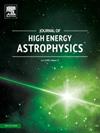经典超巨星x射线双星4U 1907+09的变异性研究
IF 10.5
4区 物理与天体物理
Q1 ASTRONOMY & ASTROPHYSICS
引用次数: 0
摘要
我们利用2024年新的核星观测资料研究了超巨星x射线双星4U 1907+09的x射线变异性。与以往的核星观测不同,该源在当前观测期间显示出显著的通量变化。光曲线呈现出暗沉(关闭状态)和耀斑(打开状态)。通态时相参时序分析得到脉冲周期为443.99(4)s,表明脉冲星的自旋持续下降。脉冲谱为非对称双峰结构,双峰相距为0.47。在~ 17.6keV也检测到回旋共振散射特征(CRSF),以及它在~ 38keV的谐波,持续存在于所有通量状态。通量分辨光谱显示,尽管通量变化了25倍,但CRSF能量保持不变。光谱参数如光子指数和e折叠能量与脉冲形状不一致,而截止能量与脉冲形状一致。在导通状态期间,源的光度为2.85×1035ergs−1,与无碰撞气体介导的激波在此通量水平下预期的“铅笔”束辐射模式一致。这些结果为该系统的吸积动力学和磁场几何结构提供了进一步的见解。本文章由计算机程序翻译,如有差异,请以英文原文为准。
Variability study of classical supergiant X-ray binary 4U 1907+09 using NuSTAR
We investigate the X-ray variability of the supergiant X-ray binary 4U 1907+09 using the new NuSTAR observation of 2024. Unlike the previous NuSTAR observations, the source shows significant flux variation during the current one. The light curve exhibits dips (off-state) and flares (on-state). The phase-coherent timing analysis during the on-state yields a pulse period of , showing the pulsar's continued spin-down. The pulse profiles show an asymmetric double-peaked structure with a phase separation of 0.47 between the two peaks. A cyclotron resonance scattering feature (CRSF) is also detected at , along with its harmonic at , persisting across all flux states. Flux-resolved spectroscopy reveals that the CRSF energy remains constant despite a 25-fold change in flux. The spectral parameters, like photon index and e-fold energy, are out of phase with the pulse shape, whereas the cutoff energy is in phase with the pulse shape. The source's luminosity during the on-state is , consistent with a “pencil” beam radiation pattern expected at this flux level from a collisionless gas-mediated shock. These results offer further insights into the accretion dynamics and magnetic field geometry of this system.
求助全文
通过发布文献求助,成功后即可免费获取论文全文。
去求助
来源期刊

Journal of High Energy Astrophysics
Earth and Planetary Sciences-Space and Planetary Science
CiteScore
9.70
自引率
5.30%
发文量
38
审稿时长
65 days
期刊介绍:
The journal welcomes manuscripts on theoretical models, simulations, and observations of highly energetic astrophysical objects both in our Galaxy and beyond. Among those, black holes at all scales, neutron stars, pulsars and their nebula, binaries, novae and supernovae, their remnants, active galaxies, and clusters are just a few examples. The journal will consider research across the whole electromagnetic spectrum, as well as research using various messengers, such as gravitational waves or neutrinos. Effects of high-energy phenomena on cosmology and star-formation, results from dedicated surveys expanding the knowledge of extreme environments, and astrophysical implications of dark matter are also welcomed topics.
 求助内容:
求助内容: 应助结果提醒方式:
应助结果提醒方式:


